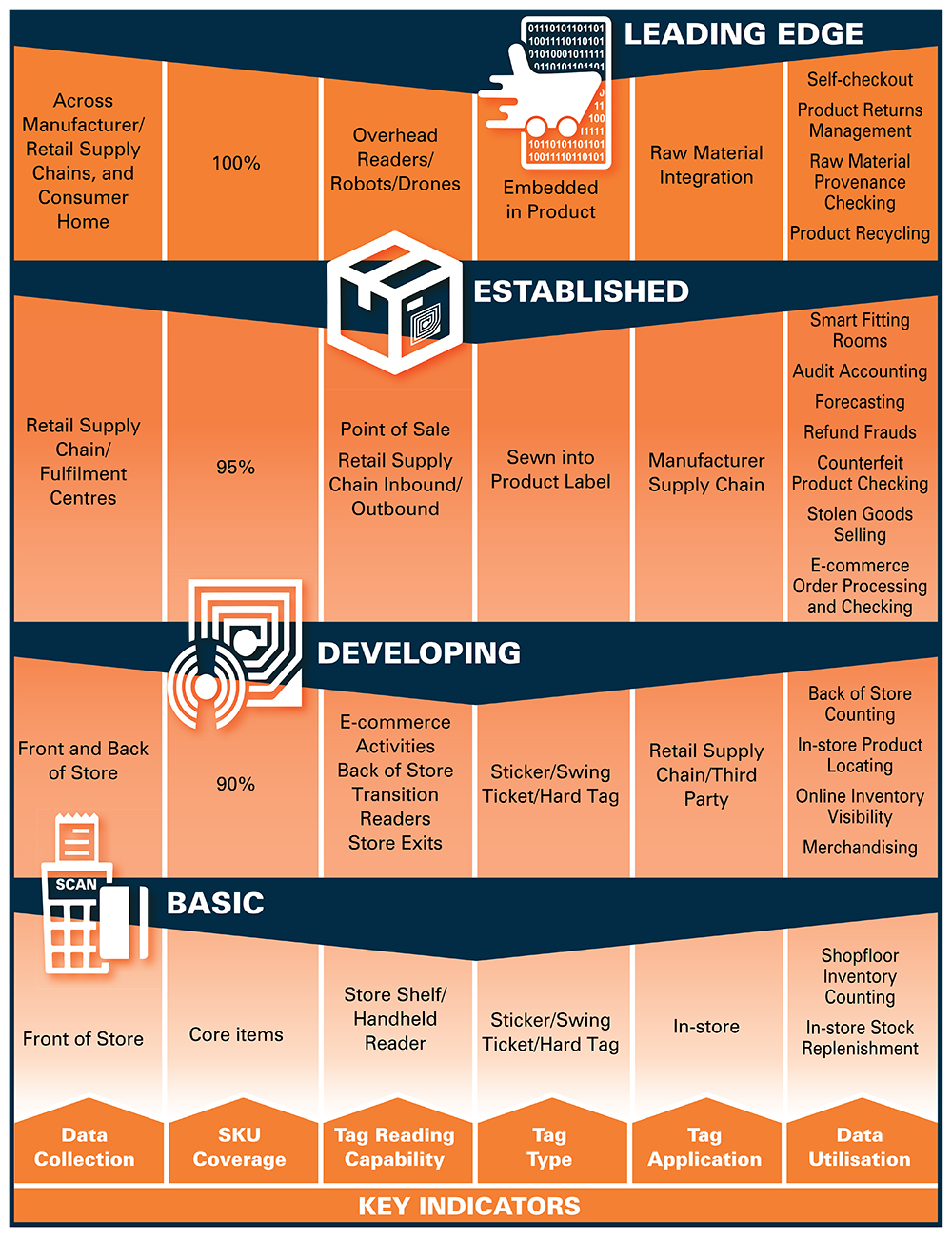A new report issued by ECR Retail Loss Group, “Utilizing RFID in Retailing: Insights On Innovation,” is built upon a previous study by the organization published in 2018, titled “Measuring the Impact of RFID in Retailing: Key Lessons from 10 Case-study Companies.” This latest research, conducted by Adrian Beck, an Emeritus Professor at the University of Leicester, provides insights into how retailers evolve their radio frequency identification systems, while exploring the ways in which some companies innovate. The report is based upon an online survey and interviews carried out with a variety of businesses currently employing RFID technologies.

Adrian Beck
According to Beck, the core business case identified in the 2018 study remained a consistent strategy: counting stock in retail stores via a handheld reader to improve inventory accuracy. The primary justification, he says, was the technology’s ability to increase sales, reduce staff costs and stock holding, and bring down the value of retail losses. Beyond this, innovation was largely found to be incremental and bound by the need for a robust business case. The study found that as businesses become more established in their use of RFID data, additional use cases are gradually added to their business-as-usual (BAU) practices. These include the following:
- Streamlining the audit process: The capacity to collect inventory data with RFID, the research indicates, meant companies were now using it to replace their routinized but infrequent stock-takes. This resulted in savings in terms of audit costs, Beck says, while providing more in-depth insights into inventory management.
- Improving store processes: Greater stock visibility enabled users to target the problem of pseudo out-of-stocks—that is, goods not available on a shelf but located in a store’s back room. This was done by using targeted pick lists. RFID improved the speed of stock searching, which helped considerably with ship-from-store omnichannel activities.
- Utilizing smart fitting room and magic mirrors: While these still were not commonplace, the research showed that some companies understood how to generate value, particularly when their impact was measured through customer satisfaction rather than direct profit improvement.
For many retailers, Beck explains, the omnichannel model is now regarded as BAU, and RFID is seen as a key facilitator in its delivery. This was evidenced through:
- Using physical stores as fulfilment centers: Without the inventory accuracy offered by RFID, few respondents said they believed they could use their stores to fulfil online orders. For one retailer, only RFID-enabled stock was available for online purchase. For another, this use of stores increased inventory turnover, reduced markdowns and optimized working capital.
- Improving online order accuracy: Where online orders are collated manually, errors can occur, generating customer complaints and increased returns. One retailer used RFID to check picked items against orders, claiming a 90 percent reduction in incorrect orders and customer complaints.
While most respondents to the research stated that they were now using RFID in their supply chain, some said they were cautious in the extent to which it could bring value. The main use cases were focused on checking the accuracy of inbound and outbound shipments and improving the accuracy of distribution center (DC) inventories. Where DCs were being used as online fulfilment centres, RFID brought value to this process. However, making a business case for using RFID to monitor inventories in the retail supply chain was viewed as challenging by several respondents.
 Only a single respondent was currently using RFID to deliver self-checkout (SCO). Its relative scarcity was due, in part, to the need to have 100 percent of stock-keeping units (SKUs) tagged, and for read reliability to be very high. However, the use of RFID at the SCO level was found to deliver several benefits:
Only a single respondent was currently using RFID to deliver self-checkout (SCO). Its relative scarcity was due, in part, to the need to have 100 percent of stock-keeping units (SKUs) tagged, and for read reliability to be very high. However, the use of RFID at the SCO level was found to deliver several benefits:
- Speed of checkout: Since RFID does not require line of sight reading for product identification, far more products can be registered at the checkout at the same time (bulk reading).
- Loss control: Automating the product-recognition and -registration process makes it considerably harder for errant users to non-scan items or misrepresent one product for another.
- Customer service benefits: RFID significantly reduces the likelihood of double scanning, in which a consumer inadvertently registers the same item more than once. In addition, the report notes, employees formerly assigned to checkout can now be redeployed to more sales-driven activities on the shop floor.
While none of the retailers argued that reducing loss was their primary reason for investing in RFID, Beck says, many reported that they were now reaping more indirect benefits in the area of loss prevention. These include:
- Tackling refund frauds: By identifying goods uniquely, RFID can target thieves returning non-purchased products. This is potentially a game changer, Beck notes, but it does require RFID to interact with the electronic point-of-sale (EPOS), as well as the RFID tag to have not been removed, and a returns policy that facilitates such an approach.
- Enabling dynamic product loss profiling: A lack of information regarding missing items poses a problem for loss-prevention teams. RFID data provides insights into which products are vulnerable to loss and, because of more frequent inventory checking, enables the performance of interventions to be quickly and accurately assessed.
- Stolen product identification: For one U.S. retailer, handheld RFID scanners were being used at open-air markets to check products being offered for sale. The RFID data was used to understand their origin and whether they were stolen.
The research identified stages of maturity in the use of RFID in retailing, Beck reports, ranging from basic and developing approaches through more established utilization modes and on to what can be regarded as leading-edge use. Most retailers in this study were viewed as being at the basic and developing stages, he says, with relatively few having a more established profile—and hardly any that could be considered as leading-edge.
“It seems clear that for many adopters, the use of RFID is an incremental journey,” Beck says. “As viable business cases emerge, then its use further develops. Above all, RFID data is increasingly viewed as an indispensable ‘electronic spine’ for many retail users operating in an omnichannel world.” A free copy of the new report can be downloaded here, while the 2018 study is available here. For further information, contact Beck at [email protected].



